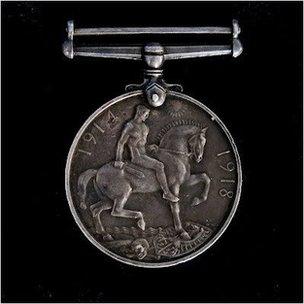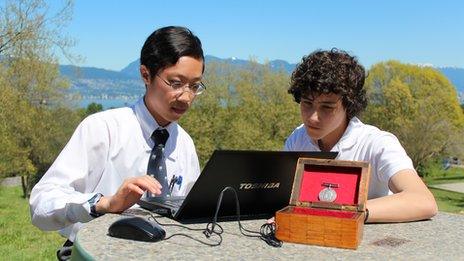Students uncover Scottish soldier behind mystery World War I medal
- Published

Pte Gibson was killed along with 37 other soldiers near Basra in modern day Iraq in 1917
A class of Canadian schoolchildren who unearthed the Scottish story behind a mystery World War I medal are appealing to find the family of its owner.
The service medal, which bears the name of Pte Andrew Gibson, was found at the bottom of a box of junk by a member of staff at the school in Vancouver.
After an international hunt, the students traced his name to the Scottish regiment, the Black Watch.
The pupils are now looking for Pte Gibson's relatives to return the medal.
Pte Gibson, from Clackmannanshire, died in fighting in Mesopotamia in 1917, near Basra in modern day Iraq.
Box of trinkets
A receptionist at West Point Grey Academy in Vancouver first unearthed the medal at the bottom of a box of trinkets from an auction in Victoria, British Columbia.
She passed the medal to the students, who polished it and discovered Pte Gibson's name inscribed around the edge.
Teacher Brian Roodnick said: "Many of our students, taught 'we shall remember them' were saddened that this young soldier's medal had been forgotten and immediately set out to uncover his story.
"They had so many questions: Who was he? How did his medal end up in a box of trinkets in Victoria? Did he have any surviving family?"
The class initially assumed that Pte Gibson was a soldier of the Canadian Black Watch.

Students Henry Chen and Bradley Huygens who helped uncover the history of the medal
But after a search of archival records came back blank, they turned their sights to Scotland.
Mr Roodnick said that while many veterans' records from WWI were destroyed during WWII, enough had survived to partially trace Pte Gibson's life and service.
A letter from the students to Prince Charles, honorary colonel of the Black Watch, that was passed to the Black Watch Museum in Perth, provided the final piece of the jigsaw.
Not forgotten
Pte Andrew Gibson was born in 1891 to Andrew and Maggie Gibson, and appears to have had a tough childhood.
He lost his father when he was nine, and his little sister died of tuberculosis in 1914. His brother died in France in 1916.
After enlisting in Scotland, Pte Gibson arrived in France in 1915 and was assigned to the 2nd Battalion of the Black Watch.
The battalion fought the Turks in Mesopotamia until the end of the war.
"Pte Gibson survived these early battles, and fought with the Black Watch for the next two years up the valley of the Tigris and Euphrates rivers, as Baghdad was liberated and the Turks were pushed up the valley," Mr Roodnick said.
On April 21, 1917, the battalion came under heavy fire.
Pte Gibson was killed along with 37 other Black Watch soldiers and two officers. Another 155 were wounded.
He is thought to have been buried in Iraq. An account by JR Lowell, published in 1919, describes the day.
"We dropped into a plain, and saw the Hero's Way by which the others had gone. Dead Gurkhas and Highlanders lay everywhere.
"I have always felt that the sight of a dead Highlander touches even deeper springs of pathos than the sight of any other corpse.
"Analysed, the feeling comes to this, I think: in his kilt he seems so obviously a peasant, lying murdered on the breast of the Universal Mother."
The class at West Point Grey Academy are now looking for living members of Pte Gibson's family, and have been promised an 'A' grade if they connect the medal with its owner.
They hope to return the medal in time for Remembrance Day in November.
Another clue might be the box that held the medal, which is made from matchsticks and embossed with an anchor and a crown.
Student Bradley Huygens, 14, said: "No-one who gives their life for others deserves to be forgotten. It's just wrong to forget someone who died for our freedom."